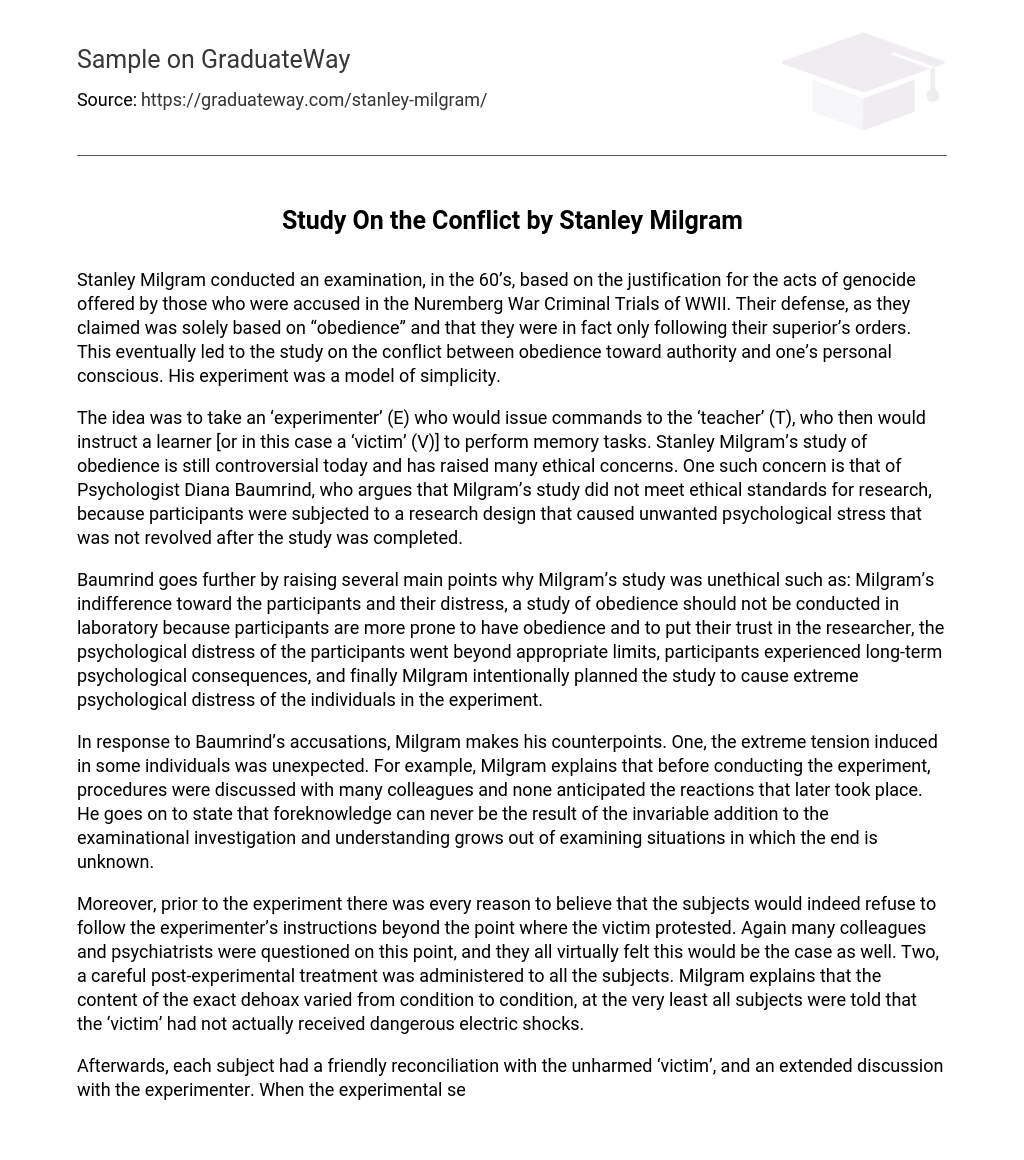Stanley Milgram conducted an examination, in the 60’s, based on the justification for the acts of genocide offered by those who were accused in the Nuremberg War Criminal Trials of WWII. Their defense, as they claimed was solely based on “obedience” and that they were in fact only following their superior’s orders. This eventually led to the study on the conflict between obedience toward authority and one’s personal conscious. His experiment was a model of simplicity.
The idea was to take an ‘experimenter’ (E) who would issue commands to the ‘teacher’ (T), who then would instruct a learner [or in this case a ‘victim’ (V)] to perform memory tasks. Stanley Milgram’s study of obedience is still controversial today and has raised many ethical concerns. One such concern is that of Psychologist Diana Baumrind, who argues that Milgram’s study did not meet ethical standards for research, because participants were subjected to a research design that caused unwanted psychological stress that was not revolved after the study was completed.
Baumrind goes further by raising several main points why Milgram’s study was unethical such as: Milgram’s indifference toward the participants and their distress, a study of obedience should not be conducted in laboratory because participants are more prone to have obedience and to put their trust in the researcher, the psychological distress of the participants went beyond appropriate limits, participants experienced long-term psychological consequences, and finally Milgram intentionally planned the study to cause extreme psychological distress of the individuals in the experiment.
In response to Baumrind’s accusations, Milgram makes his counterpoints. One, the extreme tension induced in some individuals was unexpected. For example, Milgram explains that before conducting the experiment, procedures were discussed with many colleagues and none anticipated the reactions that later took place. He goes on to state that foreknowledge can never be the result of the invariable addition to the examinational investigation and understanding grows out of examining situations in which the end is unknown.
Moreover, prior to the experiment there was every reason to believe that the subjects would indeed refuse to follow the experimenter’s instructions beyond the point where the victim protested. Again many colleagues and psychiatrists were questioned on this point, and they all virtually felt this would be the case as well. Two, a careful post-experimental treatment was administered to all the subjects. Milgram explains that the content of the exact dehoax varied from condition to condition, at the very least all subjects were told that the ‘victim’ had not actually received dangerous electric shocks.
Afterwards, each subject had a friendly reconciliation with the unharmed ‘victim’, and an extended discussion with the experimenter. When the experimental series was complete, subjects received a written report which presented them details of the experimental procedures and results. Additionally, subjects received a follow-up questionnaire regarding their participation in the research, which allowed them to express thoughts and feelings about their behavior.
The survey answers further confirmed Milgram’s impression that the participants felt positively toward the experiment. A year after the experimental program, Milgram initiated an additional follow-up study. An impartial medical examiner interviewed 40 of the experimental subjects and states that “none was found by this interviewer to show signs of having been harmed by his or her experience…Each subject seemed to handle his or her task [in the experiment] in a manner consistent with well established patterns of behavior.
No evidence was found of any traumatic responses or suffering consequences. ” Lastly, three, obedience can be meaningfully studied in, and outside, of the laboratory because it namely possesses “ecological validity” in other words obedient attitudes are assumed by most subjects, in the experimental setting, and are appropriate to that setting. For example, military and job situations are particularly important settings for these contexts.
Milgram explains that a soldier’s obedience is no less meaningful because it occurs in a related military context just as a subject’s obedience is no less problematical because it occurs within a social institution called the psychological experiment. The fact that ordinary citizens are recruited to military service and, on command, perform hasher acts against people is beyond dispute. Few of them know or are concerned with the complex policy issues underlying martial action; fewer still become conscientious objectors.
Good soldiers do as they’re told on both sides of the battle line. In conclusion, Mailgram’s classic study of obedience (1964) has been accounted for by an array of theories. As tends do sometimes occur in psychology, a multitude of viewpoints on the structural and function al aspects of a phenomenon still exists today. This equivocation can be seen in the contending theories of cognitive dissonance and accessibility theory and the conceptual explanations for human social behavior.
Milgram has thus argued that the benefits of his study far outweigh any risks or harm done (and he questioned whether any harm was truly done at all). Nonetheless, the Milgram experiment would not likely be done today for three primary reasons: it knowingly subjected human participants to emotional and psychological distress, it used deceptive practices in recruiting the participants and due the deception involved and peculiar nature of the experiment, informed consent was never truly given.
Each of these is a fairly standard ethical “don’t” within the modern rules, and taken together are basically unacceptable. The stance I would take after reading this article would be that Milgram did not intentionally harm the subjects and if there is a moral to be learned it is this: everyone must be responsible for their own actions.





